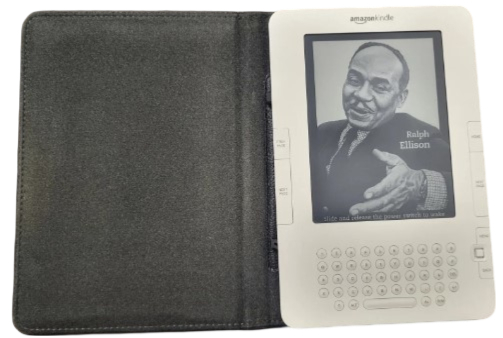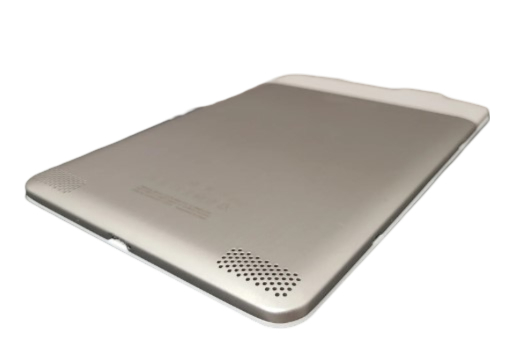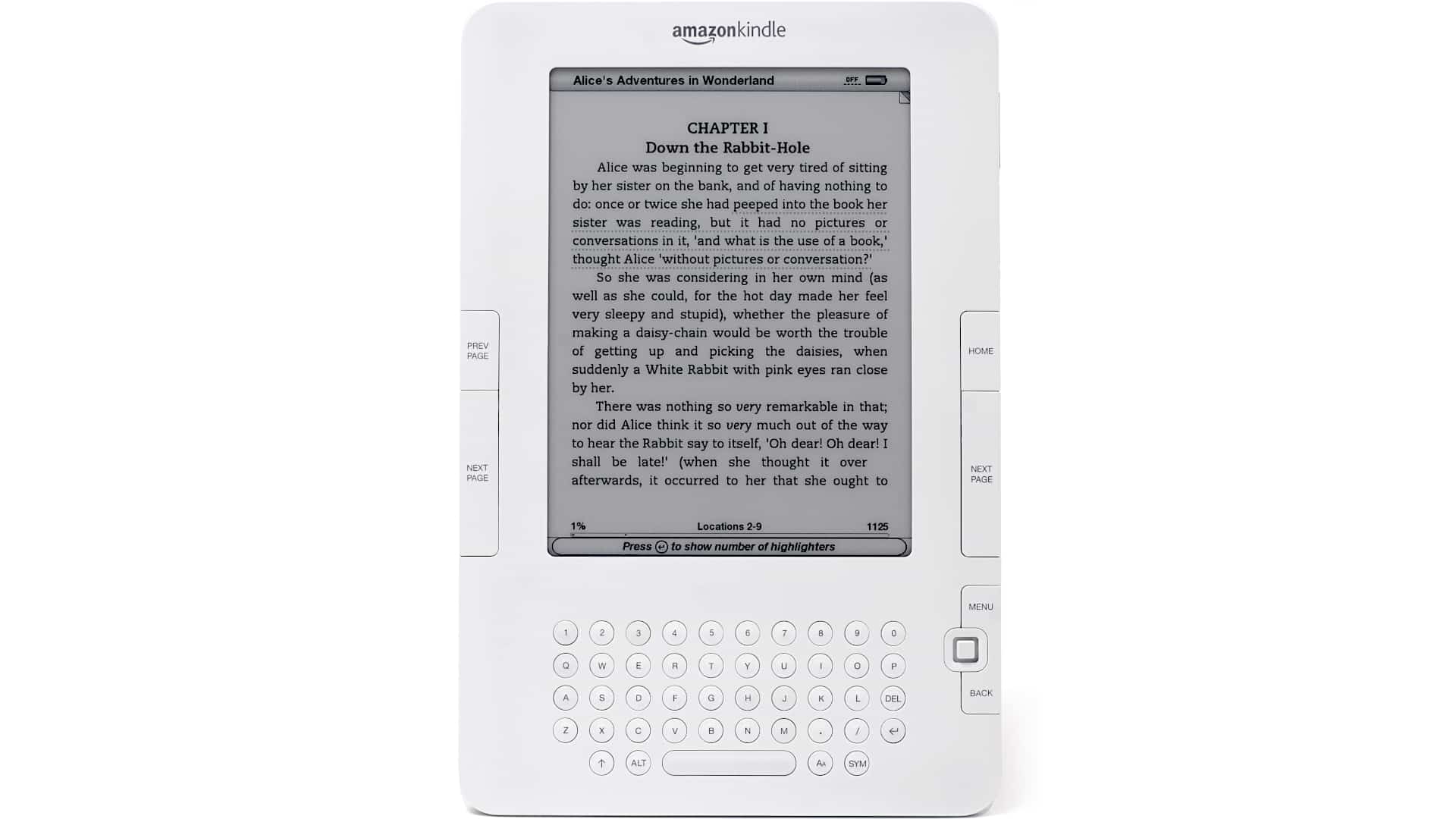In this article, I give you my Amazon Kindle 2 review with specs included and will make some comparisons to the competition. This is an ebook reader and it has some cool features like the text-to-speech.
Kindle 2 is way more attractive than the original Kindle. It lost the strange angular design and it looks sort of like a giant iPhone 1st generation.

It’s got an aluminum back cover with stereo speakers on the bottom. Plastic is on the top back side because the Sprint radio is in there that powers Whispernet.
On the top side, there is a headphone jack and a power button. On the right side are the volume keys. The micro USB syncing port is on the bottom side.
On the front, there are next page buttons on both sides. They make it pretty easy whether you’re right or left-handed to turn the page, obviously. They’ve moved the clicker to the inside of these buttons so picking it up doesn’t accidentally change the page.

The previous page button is on the left of the display. The home button is on the right of the display and pressing it takes you to your listing of all the things you have on your Kindle.
On the right of the keyboard are the menu button, back button, and the new five-way joystick that is really small but it’s actually not that hard to use.
The Blackberry-style keyboard is below the display in a very convenient position. The keys are easy to read and the spacing between them makes it easy to type.

Let’s delve into a comparative analysis between the Amazon Kindle 2 and the Sony PRS 505 reader. Upon examination, it becomes apparent that the screen quality of both devices is remarkably similar, with negligible disparities in size. However, a subtle divergence emerges in the background hue, where the Sony reader tends to exhibit a slightly whiter backdrop, although both devices predominantly feature gray backgrounds.
Notably, while the Sony Reader offers three font size options, the Kindle 2 surpasses this with a selection of five font sizes, further enhancing user customization. Moreover, the Kindle 2 presents a font style that is generally deemed more aesthetically pleasing, adding to the overall reading experience.

Transitioning to a comparison with the PRS 700, Sony’s touchscreen reader, it becomes evident that while the latter incorporates several innovative features, it falls short in terms of display clarity, particularly in brightly lit environments. The PRS 700’s display is susceptible to glare under such conditions and exhibits comparatively lower contrast levels.
However, it compensates for this with its touchscreen functionality, enabling users to interact with the device using intuitive gestures. In terms of physical dimensions, both devices boast a slender profile, with the Kindle 2 being slightly taller. Although their weights are purportedly similar based on specifications, the Sony reader may subjectively feel marginally heavier in hand.

One of the notable features of the Kindle 2 is its text-to-speech capability, which we can demonstrate using the New York Times as our reading material. Users have the option to select between a female or male voice and adjust the speech rate to one of three available speeds. Currently, we have the default setting configured, with a moderate speech rate and the female voice selected.
Furthermore, users can seamlessly navigate through pages while the text is being read aloud, enhancing accessibility and user experience. For instance, let’s transition to a different passage: “The African Medical and Research Foundation (AMREF) had expanded its initiatives to include surgical interventions aimed at training medical practitioners and nurses from diverse regions. This proactive approach facilitates expedited patient care and underscores the foundation’s commitment to enhancing healthcare accessibility and quality.”

In essence, while the Kindle 2 and Sony e-readers offer comparable screen quality and form factors, each device presents distinct features and functionalities that cater to varying user preferences and requirements.
The Amazon Kindle 2, released in 2009, was a groundbreaking e-reader that revolutionized the way people read and consume digital content. Below are extensive pros and cons of the device:
Pros:
- Ergonomic Design: The Kindle 2 boasted a sleek and slim design, making it comfortable to hold for extended reading sessions. Its lightweight construction made it easy to carry around, offering portability and convenience.
- E Ink Display: One of the standout features of the Kindle 2 was its E Ink display, which provided a paper-like reading experience with crisp text and minimal glare, even in bright sunlight. This technology mimicked the appearance of printed ink on paper, reducing eye strain and enhancing readability.
- Large Catalog of Books: As part of the Amazon ecosystem, the Kindle 2 offered access to a vast library of e-books through the Amazon Kindle Store. Users could choose from a wide selection of titles, including bestsellers, classics, and niche genres, making it easy to find and download their favorite reads.
- Wireless Connectivity: With built-in wireless connectivity (via Whispernet), the Kindle 2 enabled users to download e-books directly to their device without the need for a computer or physical connection. This seamless integration allowed for instant access to new releases and personalized recommendations.
- Long Battery Life: The Kindle 2 featured impressive battery life, lasting for weeks on a single charge, even with regular use. This extended battery performance was ideal for avid readers who enjoyed uninterrupted reading without frequent recharging.
- Annotation and Note-taking: The Kindle 2 introduced annotation and note-taking features, allowing users to highlight passages, make annotations, and bookmark pages within e-books. This enhanced functionality catered to students, researchers, and readers who wished to engage more deeply with their digital content.
- Text-to-Speech: A notable feature of the Kindle 2 was its text-to-speech capability, which enabled users to listen to e-books being read aloud. This accessibility feature provided added convenience for users with visual impairments or those who preferred audio narration.
- Dictionary Lookup: With built-in dictionary lookup functionality, the Kindle 2 allowed users to quickly access definitions of words encountered while reading. This feature promoted vocabulary development and facilitated comprehension without disrupting the reading experience.
- Whispersync: Amazon’s Whispersync technology synchronized reading progress across multiple devices, enabling seamless transitions between the Kindle 2 and other compatible devices, such as smartphones, tablets, and computers. This feature ensured continuity in reading experience across different platforms.
- PDF Support: The Kindle 2 offered support for PDF files, allowing users to view and read documents in this format directly on their device. This functionality expanded the versatility of the Kindle 2 beyond e-books, making it a useful tool for accessing a variety of digital content.
Cons:
- Monochrome Display: While the E Ink display offered excellent readability, it was limited to grayscale, lacking color capabilities. This limitation restricted the device’s suitability for viewing content such as magazines, comics, and graphic novels, which often relied on color for visual impact.
- Limited Multimedia Support: Unlike tablets and smartphones, the Kindle 2 lacked support for multimedia content such as videos, animations, and interactive elements. This restriction limited its appeal to users seeking a more immersive reading experience with multimedia integration.
- No Touchscreen: The Kindle 2 relied on physical buttons for navigation and interaction, lacking a touchscreen interface. While the button-based navigation was intuitive for many users, it fell short of the touchscreen capabilities offered by newer e-readers and mobile devices.
- Limited Storage Capacity: The Kindle 2 offered modest internal storage capacity, which could be a drawback for users with extensive e-book collections or those who wished to store additional documents and files on their device. This limitation necessitated frequent management of content to free up storage space.
- No Built-in Lighting: Unlike later iterations of the Kindle and other e-readers, the Kindle 2 did not feature built-in lighting for reading in low-light conditions. Users relied on external light sources or accessories such as book lights to illuminate the screen, which could be inconvenient in certain settings.
- Closed Ecosystem: While the Kindle 2 provided access to a vast selection of e-books through the Amazon Kindle Store, it was limited to content purchased from Amazon. Users were unable to easily access e-books from other sources or libraries, limiting their options for acquiring digital content.
- Proprietary Format: The Kindle 2 primarily supported Amazon’s proprietary e-book format (AZW), which was incompatible with other e-reader devices and platforms. This restriction prevented users from easily transferring or sharing e-books with devices outside the Kindle ecosystem.
- Non-expandable Storage: The Kindle 2 did not offer expandable storage options such as a microSD card slot, limiting users to the device’s internal storage capacity. This constraint could be problematic for users who required additional storage space for their e-book collections or personal files.
- Limited Connectivity Options: While the Kindle 2 featured wireless connectivity for downloading e-books, it lacked support for other connectivity options such as Bluetooth or cellular data. This limitation restricted the device’s versatility and limited its ability to interact with other devices or accessories.
- Reliance on Amazon Services: As part of the Amazon ecosystem, the Kindle 2 was heavily reliant on Amazon’s services and infrastructure for content delivery, software updates, and customer support. Users who preferred greater independence or flexibility may have found this dependence restrictive.
In summary, the Amazon Kindle 2 offered a compelling e-reading experience with its ergonomic design, E Ink display, and access to a vast library of e-books. However, it had its limitations, including a lack of color display, limited multimedia support, and dependence on Amazon’s ecosystem. Despite these drawbacks, the Kindle 2 remained a popular choice for avid readers seeking a dedicated e-reader device with excellent readability and long battery life.
Amazon Kindle 2
-
Performance - 94%94%
-
Price - 93%93%
-
Value - 94%94%

